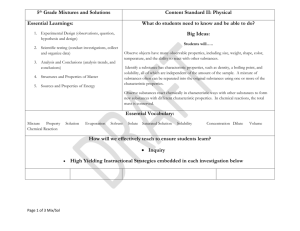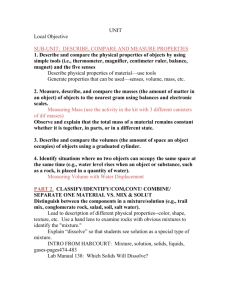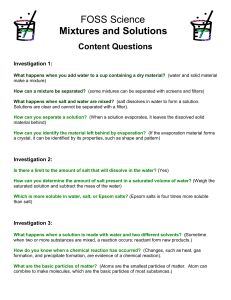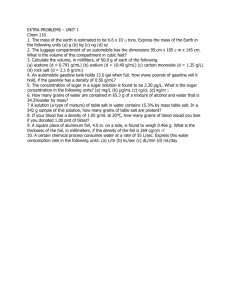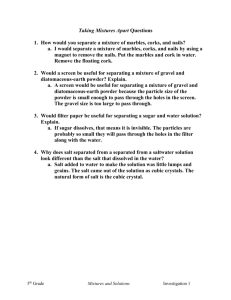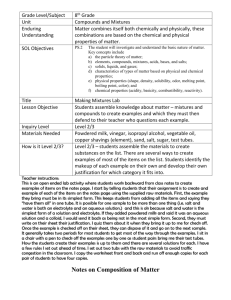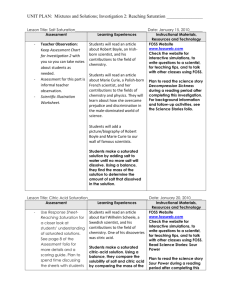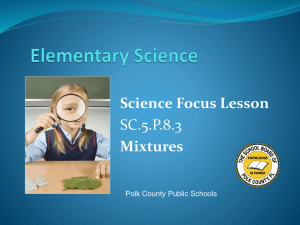Mixtures & Solutions I Check 4 Study Guide
advertisement
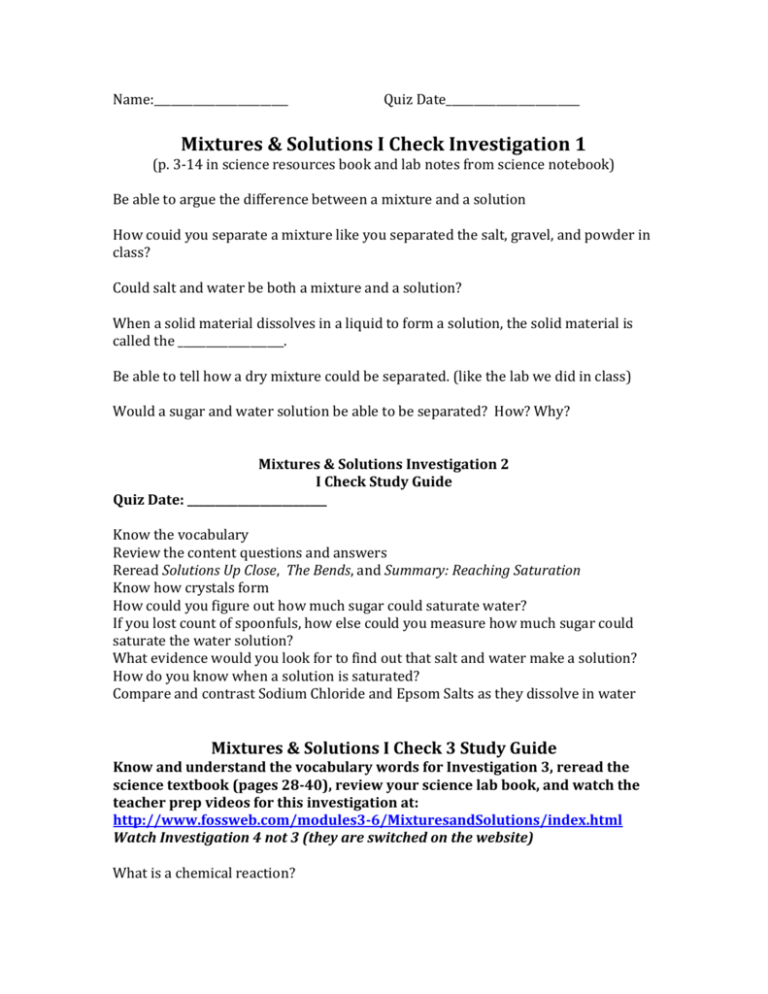
Name:________________________ Quiz Date________________________ Mixtures & Solutions I Check Investigation 1 (p. 3-14 in science resources book and lab notes from science notebook) Be able to argue the difference between a mixture and a solution How couid you separate a mixture like you separated the salt, gravel, and powder in class? Could salt and water be both a mixture and a solution? When a solid material dissolves in a liquid to form a solution, the solid material is called the ___________________. Be able to tell how a dry mixture could be separated. (like the lab we did in class) Would a sugar and water solution be able to be separated? How? Why? Mixtures & Solutions Investigation 2 I Check Study Guide Quiz Date: _________________________ Know the vocabulary Review the content questions and answers Reread Solutions Up Close, The Bends, and Summary: Reaching Saturation Know how crystals form How could you figure out how much sugar could saturate water? If you lost count of spoonfuls, how else could you measure how much sugar could saturate the water solution? What evidence would you look for to find out that salt and water make a solution? How do you know when a solution is saturated? Compare and contrast Sodium Chloride and Epsom Salts as they dissolve in water Mixtures & Solutions I Check 3 Study Guide Know and understand the vocabulary words for Investigation 3, reread the science textbook (pages 28-40), review your science lab book, and watch the teacher prep videos for this investigation at: http://www.fossweb.com/modules3-6/MixturesandSolutions/index.html Watch Investigation 4 not 3 (they are switched on the website) What is a chemical reaction? What happens to the atoms in substances when a chemical reaction occurs? If you mix two substances together, what evidence would tell you a chemical reaction occurred? What is a molecule? What is an atom? What is an element? What is a precipitate? Be able to complete chemical equations (find the chemical formulas for the products if given the chemical formulas for the reactants) What happens when mixing different substances? Review the labs where we mixed chemicals and be able to determine what happened? When sugar dissolves in water, it breaks into smaller and smaller pieces. What is the smallest piece sugar can break into and still be sugar? (atom, cube, molecule, or solution) When you mix a solid material and a liquid, what observations tell you that a chemical reaction occurred? (bubbles or fizzes, dissolves, a precipitate forms, you can see through it) Mixtures & Solutions I Check 4 Study Guide Know the names for the following chemical elements: Cl, Ca, Na, O, C, H, What is CaCl2? What is NaO3CH? What is CO2? What is CaCO3? What is the difference between the materials Co and CO? There are only 90 kinds of atoms on Earth. Why are there millions of different substances on Earth? Most organisms, plant and animal, are composed of the same five elements. What are they? What instrument would a scientist use to take a picture of atoms and molecules in well-ordered arrays? How are copper and bronze similar? How are copper and bronze different? What is the name for the substances represented by the following chemical formulas: H2O, CO2, O2, He, N2, C6H12O6? Which state of matter is each of these substances at room temperature (solid, liquid, or gas)? Elements are organized in the periodic table by their __________. Name 3 metals that are elements: What properties do they have in common? The most common elements in living organisms include: _____, _____, and _____. “Mixtures and Solutions” Unit Study Guide To study for this unit test, use your science notebook, science textbook, science section of your binder, graded quizzes, vocabulary list, and watch the teacher prep videos on http://www.fossweb.com/CA/modules3-6/grade5.html for review. 1. How do you know when a solid and a liquid form a mixture? How do you know when they form a solution? What is the difference between a mixture and a solution? Be able to identify and give examples of mixtures and solutions. 2. Know how to read an element model, or compound model. For example: Oxygen is O2, so the model would look like this… O----O, or Water is H2O, so the model might look like this… H----O----H. 3. Name two ways how you would know if a chemical reaction has occurred? 4. What is a precipitate? Give an example of a precipitate that occurred from any of our lab investigations. 5. Know which materials conduct electricity and which conduct heat. What are “precious” metals? 6. What is a saturated solution? How do you know if a solution is saturated? How could you make the extra solute dissolve once your solution is completely saturated? What does it mean when something is supersaturated? 7. What has occurred when two solutions have been mixed together and if the mixture turns a different color, like white? 8. What is the most abundant element found in the human body? What is the most abundant molecule found in the human body? 9. What are the most abundant elements found on Earth? 10. What is an alloy? Name some examples of alloys. 11. Describe the three states of matter. How can you separate: 1.) a solid from a solid, 2.) a solid from a liquid, and 3.) a liquid from a liquid? 12. What are the basic units that all matter is made of? Be able to draw and describe an atom model (protons and neutrons in the nucleus with electrons orbiting). What tool was invented recently to see actual atoms? 13. How many elements are found on Earth? What does the atomic number of an element mean? 14. Know what two ways the periodic table is organized. What were Mendeleyev’s contributions to the periodic table? 15. What is the difference between the solubility of different kinds of salt and what their resulting crystals looked like (example: table salt and Epsom salt)? 16. What was the mystery substance in Investigation 2, part 3? How did we know? 17. Know the difference between single elements and compounds. Know how many elements and how many different kinds of elements are in a compound. 18. Be able to complete a chemical equation of a chemical reaction (make sure the number of each kind of atom is the same on both sides of the arrow). Example: NaHCO3 + HCl CO2 + H2O + NaCl 19. What is the “bends” and what causes it? 20. Know the names and chemical formulas for the materials used in our investigations: water, carbon dioxide, baking soda, chalk, calcium chloride, citric acid, oxygen, nitrogen, hydrogen, hydrochloric acid, calcium carbonate, iron oxide, table salt, sugar, helium, gold, octane, etc. silver, copper, propane,

